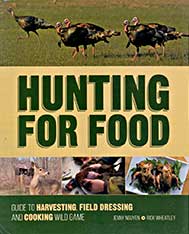 Hunting for Food: Guide to Harvesting, Field Dressing and Cooking Wild Game. By Jenny Nguyen and Rick Wheatley.
Living Ready, Iola, WI. ISBN-13: 978-1-4403-3842-7
Hunting for Food: Guide to Harvesting, Field Dressing and Cooking Wild Game. By Jenny Nguyen and Rick Wheatley.
Living Ready, Iola, WI. ISBN-13: 978-1-4403-3842-7
.
Reviewed by G. David Parris
(To reach Dave, email him at: Email).
Hunting animals for food, or “sustenance hunting” (as opposed to subsistence hunting or trophy hunting) is a subject that is gaining more attention in modern hunting circles, and it’s about time. In any modern deer camp, there has always been the hunter who gets some ribbing from the others because they choose their targets based on edibility rather than trophy-scoring status. Shooting “Bambi” instead of the big bucks is even regarded by some as emasculating or somehow wasteful. The emerging contingent, however, is getting more vocal about this flawed and unsportsmanlike logic.
More and more, simply harvesting an animal to have a trophy on the wall is falling out of favor, and those of us who choose to hunt for the food we can provide ourselves and our families seem to have more reverence and respect for the animals themselves.
Apex predators in the wild are opportunists, and very rarely do they take the strongest, healthiest animals out of a breeding population. Nguyen and Wheatley have summed it up quite well with the first few lines of the introduction of this book: “This book won’t teach you how to shoot the biggest buck. This book won’t teach you how to catch the biggest fish. Instead, it was written to show you how to hunt and catch something that you can eat, and to allow you to reconnect with the past while providing you with the skills and knowledge that you may be able to use in the future.”
This book is organized a little differently than most I have encountered. Instead of using a generalized, overall approach that narrows down to specific species, Nguyen and Wheatley have opted for a species-per-chapter approach. Thus, in Chapter 1, “Deer”, the reader gets an introduction to deer biology, then range and habitat, gear and weaponry, hunting techniques, “Field to Table” steps from field dressing to butchering, and then cooking, followed with a few recipes. The succeeding chapters are “Wild Hog”, “Rabbit”, “Squirrel”, “Wild Turkey”, “Quail”, “Dove”, “Pheasant”, “Waterfowl”, “Game Fish”, and three that I was delighted to find as they are so often omitted: “Turtle”, “Frog”, and “Crayfish”.
The information provided is concise and informative. The photographs do not shy away from the realities of cleaning, skinning, and processing wild game (which is likely a turn-off to non-hunters, but is a matter of course for those of us who desire a closer connection to our food sources). Tips and tricks are handily boxed in several sections throughout each chapter. The content seems mainly geared toward Midwesterners, as the authors are currently live in Nebraska, but they do make several references to hunting styles and species found in the West and the material easily translates to other habitats.
The book is also sturdily spiral-bound, reminiscent of cookbooks of yesteryear, making it easy and feasible for actual kitchen use. However, I tested my copy by randomly blotting some water in the “Quail” chapter, and the pages won’t hold up to many splashes, splatters, or spills from the sloppy cook like me. Still, I’m sort of reaching for the tiniest negative critique there, and the risk is negligible. This is a good book for any level of hunter, from beginner to aged woodsman.
Amazon.com: More Information or Purchase
[End of Review]


